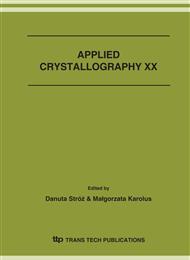p.151
p.155
p.159
p.163
p.167
p.171
p.175
p.181
p.185
Devitrification and Nano-Crystalline/Amorphous Composite Formation in Ni64Cu9Fe8P19 Glassy Alloy at Elevated Temperatures
Abstract:
The Ni64Cu9Fe8P19 alloy was prepared using 99.95 wt % Ni, 99.95 wt % Cu, 99.95 wt % Fe and Ni-P master alloy. The melt spun ribbon in as-cast state was characterized using of transmission electron microscope (TEM) and X-ray diffraction (XRD). The amorphous alloy was subjected to DTA and resistivity measurement in order to determine the thermal stability at elevated temperatures. The melt spun ribbon had a negative TCR=-2.23·10-6K-1 that is stable up to the Tg-dep=511K. At higher temperature Tg-int=560K the relative resistance starts to decrease and between 573K and 591K the rate of the decrease reaches TRC=-480.096 K-1. After the heating cycle to 633K, during cooling the alloy has a positive TRC=6.03·105 K-1. DTA curve presents the three exothermal stages with the onsets and peak values at I: Tx1=564K and T1=611K, II: Tx2=655K and T2=662K, III: Tx3=697K and T3=715K, respectively. The melting stage can be characterized by endothermic peak with Tm=1149K and Tl=1174K. On the base of the measurements the amorphous alloy was heated to the temperatures where subsequent transformations occurred. TEM study delivered information about formation of the M3P type tetragonal phosphide (a=9.040Å, c=4.462Å) nanocrystals within the amorphous matrix after the first stage of crystallization.
Info:
Periodical:
Pages:
167-170
Citation:
Online since:
December 2007
Price:
Сopyright:
© 2007 Trans Tech Publications Ltd. All Rights Reserved
Share:
Citation:


